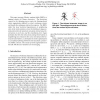Free Online Productivity Tools
i2Speak
i2Symbol
i2OCR
iTex2Img
iWeb2Print
iWeb2Shot
i2Type
iPdf2Split
iPdf2Merge
i2Bopomofo
i2Arabic
i2Style
i2Image
i2PDF
iLatex2Rtf
Sci2ools
ICPR
2006
IEEE
2006
IEEE
Stroke Segmentation of Chinese Characters Using Markov Random Fields
This paper presents Markov random fields (MRFs) to segment strokes of Chinese characters. The distortions caused by the thinning process make the thinning-based stroke segmentation difficult to extract continuous strokes and handle the ambiguous intersection regions. The MRFs reflect the local statistical dependencies at neighboring sites of the stroke skeleton, where the likelihood clique potential describes the statistical variations of directional observations at each site, and the smoothness prior clique potential describes the interactions among observations at neighboring sites. Based on the cyclic directional observations by Gabor filters, we formulate the stroke segmentation as an optimal labeling problem by the maximum a posteriori (MAP) criterion. The results of stroke segmentation on the ETL-9B character database are encouraging.
Clique Potential Describes | Computer Vision | ICPR 2006 | Stroke Segmentation | Thinning-based Stroke Segmentation |
| Added | 09 Nov 2009 |
| Updated | 09 Nov 2009 |
| Type | Conference |
| Year | 2006 |
| Where | ICPR |
| Authors | Jia Zeng, Zhi-Qiang Liu |
Comments (0)

